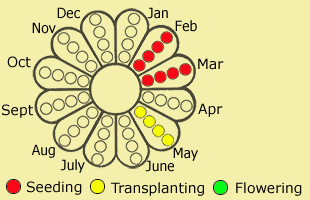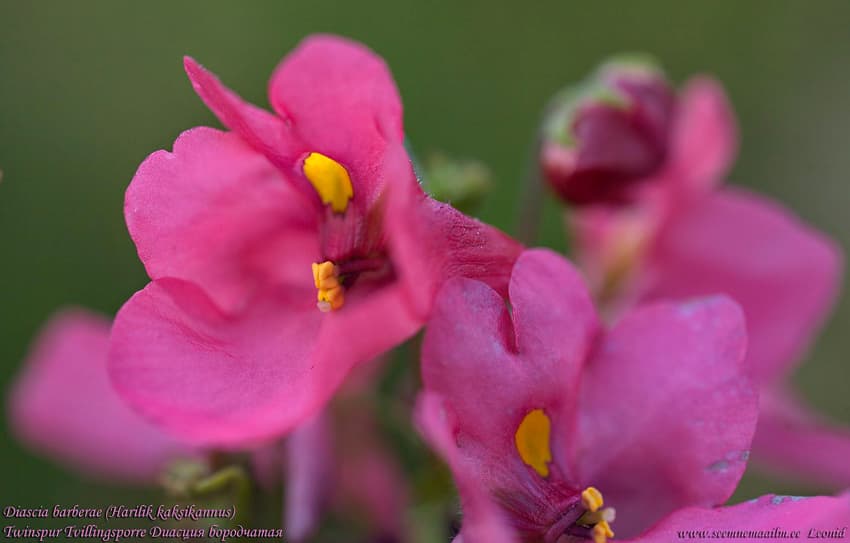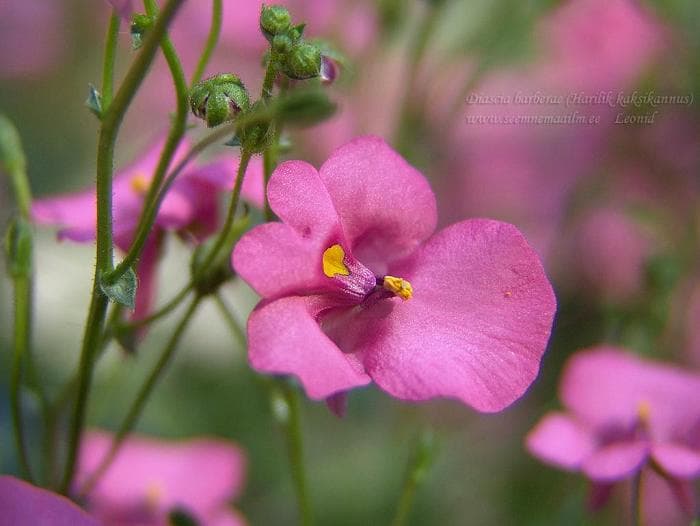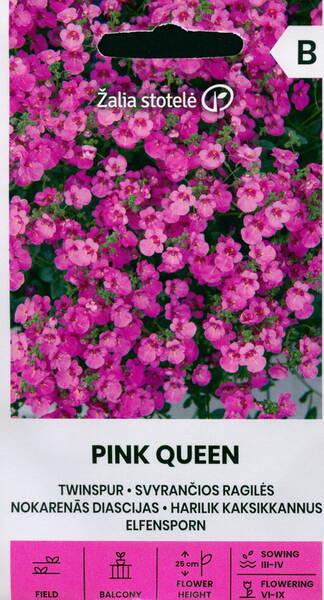A unique plant for your garden and balcony!
A plant up to 30 cm high begins to bloom already with a growth of 7-10 cm and blooms from June to the end of August. The dark green foliage forms a dense, low cushion-like curtain, over which spectacular flower stalks rise. Stems-peduncles bear numerous small, about 1.5 cm in diameter, flowers similar to shells. Colouring flowers will amaze you with an unusual soft pink colour.
Diascia is widely used for edging borders, garden paths, and paved areas in patios. It is also a great decoration for containers and hanging baskets. Looks great in the rock garden.
Agricultural technology: for seedlings in March in boxes with light soil. The seeds are germinated at a temperature of +18+20 °C, then the temperature is lowered to +15+17 °C. Needs constant watering.
The plant is planted in the ground after the first frost. Further care consists of timely watering, weeding and fertilizing.
1.0 g = 4000-4500 seeds.

Diascia barberae is an annual plant. It attracts attention with its numerous small pink flowers, resembling the shells of small molluscs, located on low, highly branched shoots 25 cm high.
Sowing in late February - in March for seedlings. Shoots appear in 10-14 days. Picking 4-6 weeks after sowing. Plant in the ground at the end of May. It is possible to sow in open ground at the end of April-May, but then flowering will come in August.
Diascia loves a sunny place and light soil with the addition of sand. The plant does not tolerate waterlogging or drying of an earthy coma. It is necessary to regularly remove wilted flowers to stimulate the formation of new buds. It is a great decoration for containers and hanging baskets, it is widely used to decorate the borders of borders and edges of garden paths.


Twinspur "Pink Queen". Diascia bаrberае.
Little visitor from South Africa. This is a juvenile, which is often considered a seasonal annual. A plant up to 30 cm high begins to bloom already at a height of 7-10 cm. The plants branch immediately, forming a wide round bush. The leaves are small, dark green and glossy. The bulk of the leaves is located at the base of the plant. Stems-peduncles bear numerous small, about 1.5 cm in diameter, flowers similar to shells. Their colour is pink in different shades with a yellow spot in the "neck". Bearded twinspur tolerates a lack of moisture much better, therefore, more than other types of twinspur, it is suitable for planting in containers in which the soil is always much drier and more saturated with air than in the open ground. This plant is widely used for bordering borders, edges of garden paths and paved areas in patios. This is a great decoration for both containers and hanging baskets. Plants of this variety are easily propagated by cuttings, but they can also be sown from seeds.
Location: twinspurs prefer a sunny location and warm summers. Under such conditions, they bloom most intensively, although they grow quite successfully in partial shade. Too much shade and too much organic fertilizer will cause excessive leaf development and shorten the flowering period.
The soil intended for planting twinspur should be loose and not too fertile. The growth of plants that have overwintered indoors is strongly stimulated by transplanting into open ground in places protected from the wind. For example, they can be placed against the south-facing wall of the house.
Care: to prolong flowering, faded stems are cut at a height of 5-7 cm. Then the plants need to be watered abundantly and fed with complex fertilizer. The stems will quickly and amicably grow back, flowering will last until the end of September.
In summer, plants need abundant watering.
In wide sale, you can find seeds of only one species, the bearded twinspur (Diascia barberae), which are sown under glass at an air temperature of + 16 + 18 ° C in February-March. The seeds are very small, in 1 g there are more than 4000 pcs. To obtain 100 plants, you need 0.3 g of seeds.
Shoots appear in two weeks at a temperature of about + 19 ° C. They are kept at a temperature of +12+16°C. Young plants are pinched several times to stimulate branching, and with the onset of warm weather in the daytime, they are taken out into the street in order to harden off. They are fairly cold hardy and can tolerate light frosts. The flowering period begins in July and lasts until September. If desired, the seeds can be sown directly in open ground in April-May. They are thinned out at a distance of 12-15 cm. However, in this case, twinspurs will not bloom until August.
Bearded twinspur blooms for 1-1.5 months.
Uses: twinspur looks especially good in pots, garden vases and various containers. In this case, they must be planted in poor soil and ensure uninterrupted watering. It can also be used as a border.












